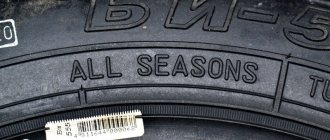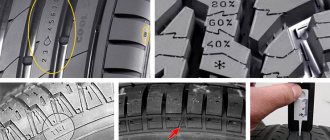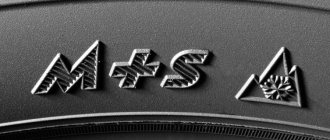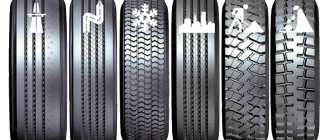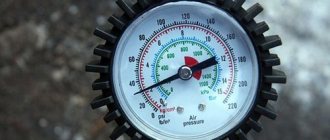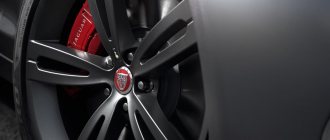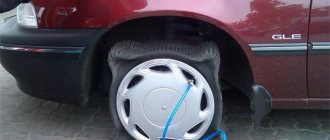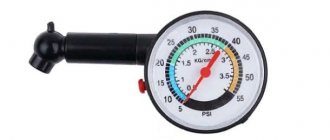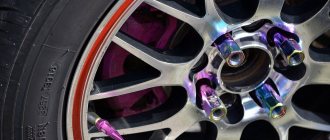MT tires: what is the designation and for which roads is it suitable?
The situation is similar with tires marked with the symbols MT, M/T and MT.
This abbreviation stands for mud terrain. That is, for surfaces and roads with dirt. These tires are chosen by motorists who often drive their SUVs through serious off-road conditions, like to relax in extreme conditions and enjoy routes that only a tractor can travel on. The specific usage of tires dictates the specific tread pattern. Since it is extremely difficult to move on an unstable road, manufacturers choose the appropriate arrangement of blocks. The MT's tread pattern is characterized by pronounced, free-standing blocks of impressive height. The distance between the ribs is huge, the pattern has a large number of sharp edges, and the so-called lugs are very noticeable on the sidewalls.
This solution allows the rubber to grip even with slippery clay, better grip on a washed-out road and not lose traction when it rains. Since there is a large distance between the blocks, the tire can be easily cleaned of dirt, water, porridge with pebbles or debris. Due to this, everything unnecessary will not “wrap around” the surface, worsening contact with the road surface and traction.
Perfectly smooth asphalt surfaces are not suitable for using MT. On such a road, the model hums, makes noise, and creates the most unfavorable acoustic environment for passengers and the driver himself. Another nuance - a high tread with sparse blocks has poorer grip on a good track.
On dry surfaces, the motorist should be especially careful not to create an emergency situation, to brake or take a turn in time
Experts strongly recommend keeping a moderate pace on the asphalt; it is better not to exceed 150-160 km/h. Maybe even less.
Tires marked HT: what kind of rubber and what features does it have?
Tires designated HT are short for highway terrain. This type of tire is designed for installation on SUVs that regularly travel on the highway. Usually they drive on highways in high-speed sedans, however, tire manufacturers have to take into account the wishes of motorists when creating their products. As more SUVs appeared on the market, capable of driving fast despite their weight, they needed a special type of tires. That’s how the HT was invented.
Since the model is designed to drive exclusively on asphalt road surfaces, the tread pattern is very similar to options for passenger cars. There are only a few differences that you won’t find in tires for sedans. The HT's profile is noticeably higher, and the sidewalls are much stiffer.
Typically, the tread consists of 4-5 thin ribs with close-fitting blocks, wide central grooves for drainage and reduction of aquaplaning, as well as a large number of transverse grooves. Sometimes the HT can be used for light off-roading, but nothing more. Even if the manufacturer says that with a careful driving style the tire behaves perfectly even off-road, this is not always true. The low tread and insufficiently convex blocks will not allow you to pass through areas with mud, serious stones and other troubles. If the HT is not used for its intended purpose, the tread pattern will quickly wear out and you will have to buy new tires within a season. Not to mention reduced safety and comfort.
Asymmetric tires, advantages and disadvantages
What pressure should be in the tires of a passenger car?
tire pressure in MPa Tire manufacturers have developed asymmetric tires. Design features, as well as the tread pattern, provide this type of tire with good wheel grip on the road surface. Our article describes the advantages and disadvantages of such tires and indicates the features of its installation.
Design features
The concept of asymmetrical tires must be understood as tires that differ in the direction of the pattern of the outer and inner sides of the treadmill. The first company to introduce the production of this type of rubber was the well-known Nokian brand, which produced tires with a directional tread pattern. Features of these tires:
- You can install tires in accordance with the direction of the arrow or the inscription “ROTATION” on the side of the tire;
- Tires are divided into left and right, marked respectively with the letters L or R.
When installing directional asymmetrical rubber, the following difficulties arose:
- It was almost impossible to install two wheels with left markings or two products with right markings, since tires with left and right markings were rarely available in one car shop.
- Determining the type of tire for a spare tire is quite difficult: it is impossible to know in advance which wheel will require replacement. In force majeure situations, drivers installed the spare wheel on the wrong side, which led to accelerated wear of the tread layer.
Tire manufacturers decided to abandon the production of asymmetric tires with a directional pattern. They were replaced by similar rubber with a non-directional tread pattern.
Non-directional asymmetric tires can be identified by the following characteristics:
- In this type of rubber, the inner side is softer than the outer. This allows you to correctly distribute the load when the car enters a turn: most of the load falls on the outer part of the product.
- The tread blocks on the outside of the tire are larger than on the inside. This design of the tread layer allows for better drainage of fluid from the grip patch of the wheels and the road surface. This reduces the risk of hydroplaning and makes driving easier.
- Car tires are installed on the left and right sides.
On symmetrical tires there is no marking on the outer and inner sides; by this feature it is easy to distinguish symmetrical tires from asymmetrical products.
We recommend watching a video about directional and asymmetrical tires:
https://youtube.com/watch?v=nlUmjDz7vac
Advantages and disadvantages, installation features
Advantages of tires with an asymmetric tread layer:
Disadvantages: significant disadvantages were present in asymmetric tires with a directional tread pattern, but this type of tire has been discontinued.
Installation of rubber with an asymmetrical tread pattern is carried out taking into account the outer and inner sides of the product. You can find out which side to mount the tires by looking at the corresponding inscription on the side of the tire. Their outer side has one of the designations:
- outside;
- side facing forwards;
- external.
The inside of the tire has one of the markings:
- this side facing inwards;
- inside.
When installing such tires, the direction of the tread pattern does not matter. Correct installation involves placing tires depending on the outside and inside of the tire.
Conclusion
Asymmetric tires are often confused with directional tires - this causes difficulties in installing these products on a car. We have indicated the distinctive characteristics and design features of tires with an asymmetrical tread pattern, which must be taken into account when purchasing and installing this type of rubber.
Purchasing tires with an asymmetric tread pattern is important when purchasing expensive tires; such a tread pattern ensures a long service life of the rubber.
Size determination
The main thing you need to pay attention to when choosing a tire is the size. This is the largest image after the manufacturer's name.
Description:
205/65 R15 94Н
Explanation:
205 — Width of the tire section in mm. Linear distance between sidewalls. The tire is measured when inflated. Protruding parts of the markings are not taken into account when measuring.
65 — Profile height. Relative value, calculated as a percentage. It is the ratio of the profile height to the section width. Profile height is the distance between the landing and outer diameters. The seat diameter is determined at the point where the tire is attached to the wheel rim.
The profile height is not indicated in the marking if its value is more than 80%. Starting from 75% onwards (5% step: 75, 70, 65...) must be applied. The larger the value, the higher the tire looks.
A tire with a height rating of 55 and below is classified as low profile. This tire has an increased tread width. Rubber gives the car sporty dynamics. Increases lateral stability during sharp turns. Reduces braking distance. It is not suitable for our road conditions because it is sensitive to road surface unevenness and cannot be used in bad weather conditions. On a wet surface, the risk of water drift increases significantly. In our conditions, it is recommended to use tires with a profile height of 70%.
R - Indicates the radial type of cord construction.
15 — Wheel rim diameter. Indicator in inches.
94 — Index of maximum load on one wheel. Expressed in kg. Reflects the critical mass at which the vehicle should not be operated. Mark 94 corresponds to a maximum weight of 670 kg.
N - Symbol of speed. Indicates the maximum threshold, exceeding which is prohibited. H corresponds to 210 km/h.
Size indicators are the main information that is used when choosing tires.
Large letters on the sidewall indicate the name of the manufacturer Bridgestone and the tire model.
What does Outside mean on tires?
Tire markings
Asymmetrical and directional tires are considered the most expensive and high-tech kits installed on cars. Such tires are capable of providing a maximum contact patch between the tire and the road, a high level of grip, and a confident response to steering turns.
Such characteristics are ensured by different patterns on the inside and outside of the tire, where one part has a “rain” tread, and the second has a “dry” tread. The outer segment of the treadmill has greater rigidity and, during fast turns, guarantees excellent grip on the road surface and stable movement of the car.
Inner segments typically have smaller blocks and have improved performance in rain, allowing water to be effectively directed away from the tread. Conventionally, such wheels can be divided into left and right, because they have different inner and outer sides of the tire and are not interchangeable.
The outside marking tells us about the outside of the wheel. This designation helps when installing tires with your own hands. A similar inscription can be found on the side of the wheel, next to the size indicators.
Design features and tire pattern
Let's start with the fact that today asymmetric tires, both summer and winter, are in great demand. The peculiarity of this asymmetric tire tread is that its inner part is softer than its outer part.
This design is dictated by the fact that the loads when driving and cornering are always higher on the outer part of the wheel. At the same time, softening the inner side made it possible to significantly improve handling and stability, and it was possible to effectively increase the area of the tire contact patch with the road.
Moreover, the tread sipes on the outside are larger than on the inside. This made it possible to achieve better drainage when driving on wet roads and significantly reduce the risk of aquaplaning.
It is for this reason that at one time manufacturers introduced “left-handed” and “right-handed” tires to the market in order to achieve high-quality water drainage (like directional tires) and maintain handling (like asymmetrical tires).
However, in reality such wheels turned out to be expensive and not as effective as expected. Added to this are the difficulties during selection. Another unpleasant thing was that drivers simply did not know which wheel to use as a spare wheel, left or right.
The fact is that you cannot know in advance where the tire will puncture, on the left or on the right. Taking into account such shortcomings, today only “right” and “left” tires are not produced.
M T tires
What do the colored marks on tires mean?
On a note! When choosing tires for an SUV, you should take into account the roads you will be driving on.
Mud tires are used to increase the cross-country ability of vehicles in off-road conditions. These can be winter and summer models. Distinctive characteristics are the tread depth, the distance between the “blocks” and the presence of lugs. The rubber compound from which the products are made is hard and dense.
Since MT tires are designed for driving in severe off-road conditions and on difficult roads, they have a low speed index. An important parameter when choosing products is the protector. The tread pattern is selected depending on the conditions in which the vehicle is operated.
The deep tread of mud tires with cut straight or jagged lines prevents wet soil from sticking to the wheels. The special track pattern provides traction on the ground. With a high and wide profile, the contact area with the surface increases, and the wheels do not sink deep into the mud.
Deep zigzag grooves facilitate quick self-cleaning of the wheel and prevent stones and other sharp objects from getting stuck in it.
A large number of sipes and an elastic rubber compound provide good grip on winter roads. The tire is very durable - its design uses a double steel belt and three layers of cord made of polymer materials.
Lateral lugs are present only on rubber of this type in the shoulder area, providing good grip on loose surfaces. They serve to provide greater traction in mud, making it easier to get out of such conditions without loading up.
When driving on sandy and swampy soils, use soft tires, and on rocky soils, use hard tires. Soft tires have a herringbone tread pattern, while hard tires have a large-block tread pattern. Connecting front-wheel drive is only possible on the ground, and front-wheel drive on MT tires pulls the entire car behind it.
Note! MT tires are not used for city driving because the car's controllability is reduced, the tires wear out quickly and are quite noisy due to their wide and deep sipes. 80% rubber is designed for off-road travel and 20% for hard surfaces.
MT tire performance:
MT tires
- high cross-country ability on off-road and unpaved roads;
- poor handling on asphalt;
- high noise level;
- low speed capabilities.
Special MT tires are selected according to the following parameters:
- the required size of products;
- tread pattern;
- speed index.
Mud tires MT 215 65 16 with a width of 215 mm, a profile of 65%, and a wheel size of 16 inches are suitable for most SUVs for driving in serious off-road conditions:
- recommended for installation on SUVs specially prepared for off-road use;
- Designed for use on sandy, clayey and marshy soils and in mountainous areas.
Tires for Niva in 16 diameter
How long to run?
There is also an additional small pattern on tires. As soon as the pattern has ceased to be visible (that is, the running layer has been erased), the tire begins to work at full capacity
The numbers 2116 on this tire indicate that it was released in May 2021 (week 21)
Next to the word DOT you can also find the manufacturer's internal information. In this case it is 60RB, which means plant code, lot number, mold information or something similar. If there are only three numbers, then you need to run from such tires like fire or use them for decorative purposes, for example, to make a flower bed. Three numbers are present on tires manufactured before 2000. The first two digits are the week, and the last one is the year, and such a tire can be either from the 90s (you can tell by the triangle next to it) or from the 80s (if there is no triangle).
What do the numbers on car tires made in the USA mean?
On American tires you can find two different types of markings that differ from each other.
Let's consider the first marking: P 195/60 R 14 or LT 235/75 R15. As you can see, it is practically no different from the European one. However, the size is preceded by the letter P on passenger tires or LT on tires for light trucks.
There is also a second marking, it looks different: 31x10.5 R15. In this case, the usual European marking would look like this: 265/75 R15. What do the numbers on tires with this marking mean (in inches):
- 31 — outer diameter of the tire;
- 5 - the number means the width of the wheel;
- R - the letter means that the tire has a radial design. Initially, rubber was produced with a bias construction, but this method of making tires has become outdated;
- 15 - this number means the inner diameter of the tire.
It is worth noting that if you do not pay attention to the units of measurement (unusual inches), then the American markings will be clearer and more logical in comparison with the European ones. Indeed, in the second case, the height of the rubber profile depends on the width of the wheel
In American labeling, everything is simpler. For clarity, let’s look at what the first number in tire size means. It shows the standard size, that is, the outer diameter. The second number indicates the width, the third indicates the internal diameter.
How to find out the width of a tire in our usual units of measurement, that is, in mm? To do this, you need to multiply the width in inches 10.5 by 25.4, because one inch equals 2.54 cm. The result is 267 mm. Since this size is not available, we take into account the width of the tire 265, which is obtained after rounding.
The next step is to find out the height of the sidewall, which is measured as a percentage. To do this, we perform the following steps: subtract the bore diameter from the outer diameter. Then we divide the resulting value by 2. The figure we get must then be divided by the width of the profile.
Thus, in our example we have the following: ((31 - 15) : 2) : 10.5 = 0.76. The resulting value must be rounded to 75. As a result, we will have the following markings on the tires: 265/75 R15.
If the profile height is not indicated on the tire, do not forget that for passenger tires this figure is 80–82%, for truck tires 88%.
To convert from the metric to the inch system we will need to perform calculations
- Find the diameter by multiplying the tire width of 265 mm by the profile height of 0.75. Then multiply the resulting value by two. As a result, you will get 397.5. It should be converted to inches (divided by 25.4), and then added to the wheel diameter: 15.6 + 15, you get 30.6. To make it more convenient, you need to round the number up. At the end of some simple math, you will find the tire diameter in inches.
- How to determine the width of a tire in inches? To do this, divide the width in millimeters 265 by 25.4. We get a value of 10.4 inches.
So, we figured out what the numbers on tires with the American marking 31 * 10.5 R15 mean
Serdgik61 › Blog › Designations on tires (Revealing myths and problems)
All car tire manufacturers mark their products according to general requirements, so all the main characteristics can be determined by reading the markings printed on the sidewall of the tire.
Tire size
- this is the main characteristic of the tire, applied to the side in an approved format and shows its purpose, form factor and type of construction. Example of size marking:
Tire type [P]
– (Service Type) optional designation (required by DOT for North America), indicates the purpose of the tire. Possible values: P - (Passenger car designation) passenger car, LT - (Light Truck) light truck, ST - (Special Trailer) trailer, T - (Temporary) temporary, used only for spare tires.
Tire width [170]
– (section width) the width of the tire profile in millimeters from one sidewall to the other.
Profile width to height ratio [65]
– (aspect ratio) the percentage ratio of the tire profile width to its width, in this example 65 means that “tire width” / “tire height” = 65%. If this designation is absent, then it is considered equal to 82%.
Tire design [R]
– (Internal Construction) designation indicating the construction features of the tire cord. Possible values: R – (Radial) radial-type tire casing (a common mistake is when the letter R is mistaken for a radius designation). In radial tires, the tire carcass cord is stretched from bead to bead and the rubberized threads do not overlap, but lie parallel to each other along the entire circumference of the tire and thereby form a carcass layer. D - (Diagonal) diagonal type of frame. The peculiarity of the construction of bias-ply tires is that the cord threads are located at an angle to the radius of the wheel. In one layer the threads go in one direction, in the other layer - in the opposite direction. As a result, the threads of neighboring layers intersect. B - (Bias belt) diagonally belted tire. The frame of a tire of this design is similar to bias-ply tires, but such a tire also has a breaker, like radial tires. If this designation is absent, it means that the tire has a diagonal carcass type.
What are outside and inside tires?
There are three types of tire tread patterns: symmetrical, asymmetrical and directional.
An asymmetric tire conventionally consists of two halves: outer and outer, which have their own pattern and arrangement of blocks. To understand which side of the tire should look inside the car and which outside, there are inscriptions on the sidewall - inside and outside.
Compliance with the marks is very important, since its functionality depends on the position of the tire on the car: braking performance, handling, noise level, resistance to aquaplaning, and so on. For example, the outer side often has a small stiffening rib that strengthens the tread blocks and maintains their shape during high-speed maneuvers.
Tire asymmetry is not always visible
Some tires have a pronounced tread asymmetry, so the difference is immediately noticeable.
However, on many tires the difference between the tread halves is less significant, and without careful inspection it can be difficult to detect.
Correct installation of the outside inside tire
In order for an asymmetric tire to behave correctly on the road, it must be installed in accordance with the marks: outside - outward, inside - inward.
It happens that visually the tires on the right and left axles look in different directions, as if they are installed in opposite directions. However, if the tire marks are pointing in the right directions, then the tire is installed on the car correctly.
Tweet
Share
Plus
Share
Send
Class
Installing an outside-inside bus
What else does a driver need to know about such tires? The most important thing is their correct installation on the car. Some car enthusiasts are puzzled by the fact that when mounting tires, the latter look asymmetrical. It begins to seem to them that the wheels are in reverse. But don’t be afraid, this situation when installing asymmetrical non-directional tires is completely normal. Such rubber has no direction of rotation. Therefore, it can be installed without fear on any car wheel, both right and left.
But when installing such rubber, the basic condition must be observed. Tires are marked both inside and outside. You should pay attention to these inscriptions. The most important thing is that after installing the tires, the word “Outside” should “look” at the car enthusiast. It denotes the outer side of the tire. The inscription “Inside” is internal and should not be visible.
True, such words can be written in several ways. For example, it could be Cote Interieur (internal part) or Cote Exterieur (external part). Therefore, when purchasing such tires, you need to attach great importance to this issue, it is advisable to consult with specialists.
SUV tires
First, let's take a closer look at studless tires. The debate here is between two classes of all-season tires: AT and MT.
Features of AT class tires
AT is an abbreviation for All-Terrain, which means “for all types of surfaces.” Such tires are considered universal and, according to manufacturers, should perform equally well both on asphalt and off-road conditions (different manufacturers recommend using them on asphalt and off-road conditions in a ratio of 60/40 to 40/60).
On paved roads they actually perform very well up to 140 km/h. By definition, SUVs do not need to drive faster. For urban conditions, All-Terrain tires are almost ideal. But during suburban driving at high speeds, their disadvantages become noticeable: they increase fuel consumption due to increased rolling resistance, are prone to aquaplaning, are harsh and noisy, and also have an increased braking distance compared to road tires.
The situation in off-road conditions is much worse. On rocky or dry loose soil the tires perform quite well. But as soon as you drive into clay, mud or snow, the tread quickly becomes clogged and turns into a slick. The wheels suddenly lose their grip and the car becomes uncontrollable.
The reason for this behavior lies in the tread pattern. At first glance, it is quite aggressive and deep, but the distance between the blocks is very small. As a result, the tread easily becomes clogged with mud or snow, but is difficult to clear at low speeds typical of off-road driving. Poor self-cleaning is the most serious drawback of AT tires. They are not suitable for off-road use. Their ceiling is the countryside.
Features of MT class tires
MT is an abbreviation for Mud-Terrain, which means "for mud." These tires are originally designed for use in off-road conditions. On asphalt they are not even worth comparing with the AT type, to which they are inferior in almost all respects.
In the vast majority of cases, MT tires behave more or less tolerably at speeds up to 80 km/h. You should not accelerate faster, because the grip of the tires on the asphalt is quite weak and the car may become uncontrollable. Among the disadvantages of tires are increased braking distance, high noise, increased fuel consumption due to high rolling resistance and increased wear. All these indicators are worse than those of AT.
But in off-road conditions the situation changes dramatically. Mud-Terrain tires are not afraid of either dirt or snow, and the car turns into a lightweight, tuned version of a tank or tractor. The main thing is not to overdo it with the gas pedal, because on soft ground you can end up lying on your belly.
The reason for this tire behavior also lies in the tread. He is aggressive, deep, with large distances between checkers. This feature provides the tires with good grip on soft ground, in mud or snow and the ability to self-clean, but worsens their behavior on asphalt. They are not suitable for city driving. The minimum is rural areas. Briefly, the behavior of such tires can be described as follows: the worse the road, the better they ride.
Results
| terms of Use | AT | MT |
| Asphalt road |
|
|
| Off-road |
|
|
So, based on the characteristics of AT and MT tires, we can draw the following conclusions:
- AT tires are suitable for driving in the city and in rural areas on slightly broken dirt roads.
- MT tires are contraindicated for the city. They are optimal for real off-road conditions with mud, puddles, holes and the complete absence of a road.
TYPES OF TIRE
, road, all-season and universal ones are most widely used.
types of tires.
Road tires
(commonly called summer tires) are designed for use at positive temperatures on highways.
Tires of this type provide the best grip on dry and wet hard surfaces, fuel efficiency, have maximum wear resistance and are best suited for high-speed driving. They are of little use for driving on dirt roads (especially wet ones) and in winter. The tread pattern is distinguished by clearly defined longitudinal grooves for draining water from the contact patch between the tread and the road, weakly defined transverse grooves and the absence of a micropattern. In addition, they have a mandatory smooth (rounded) transition from the tread to the sidewalls. All-season tires
are a compromise between summer and winter tires, and therefore are inferior in terms of traction when used in the corresponding season.
They are adapted to work on dry and wet asphalt, for winter roads, provide a good level of comfort and satisfactory efficiency, but are characterized by slightly greater wear than summer ones. One set of such tires ensures acceptable performance of the vehicle during year-round operation. The tread pattern of an all-season tire is more branched, with the elements of the pattern grouped into a clearly visible “track” and separated by grooves of different widths. Large elements of the pattern have narrow slots (lamellas) that provide traction on icy or snowy roads. As a rule, these tires are marked with all season, tous terrain or conventional symbols (snowflake or drop). Universal tires
(according to domestic terminology) are designed to work on roads of any quality. Moreover, it can be quite difficult to draw a clear boundary between them and all-season ones. They differ primarily in their deeper and more branched tread pattern. The fact is that roads of “any quality” in the CIS can be understood as 60–80% of all roads, including off-road, so this type of tire is in many ways a domestic invention. By Western standards, tires of the M+S type (Mud and Snow - mud and snow) can be classified as universal tires in a version with a tread pattern less dissected by grooves, with a weakly expressed micropattern or without it.
Pressure: What should you observe when inflating a tire?
To be able to evaluate a tire accurately and in detail, it is important that all its properties are tested. In principle, the pressure should be checked regularly once a month, cold and not forgetting the spare tire
Indeed, driving with underloaded tires is dangerous, and wear at the top of the tire increases faster. The service manual contains all the information about the correct pressure.
On several vehicles, pressure levels are also indicated on the door frame or inside the fuel filler flapper. In case of high load or high speed running, the pressure should be increased by 0.2 bar. Increasing the pressure to 0.5 bar certainly improves performance, but slightly reduces driving comfort.
Tire homologation.
In order to improve the performance characteristics of tires, manufacturers homologate them. In simple terms, they produce tires for cars of a certain manufacturer. Here is the homologation marking for the main manufacturers:
- Mercedes-Benz - MO and variations for certain models, for example, MO1 for the SL65 AMG;
- Porsche - N and a number, for example, N0, N1, N2, N, in some cases are also suitable for Volkswagen Touareg;
- Audi – general marking AO, for the Quattro model range – RO;
- BMW – homologation is hidden under the * icon, for the M-series * BMW;
- Ferrari - tires for horses from the Italian stable are designated K1;
- Jaguar - tires for English kittens are marked with the letter J.
The list goes on, if you find such a marking, then contact the manufacturer’s website.
American labeling system
The above is the European notation system. American markings are applied in accordance with the quality standards of the US Department of Transportation. Such tires are produced for use in the North American states. All designations are expressed in inches.
Marking 31 X 10.5 R 15
Explanation:
31 — Tire outer diameter
10.5 — Section size
R — Radial arrangement of cord threads
15 — Bore diameter
How to Determine Tire Tread Direction
Tire rotation direction
If the car pulls to the side when driving and the tires quickly wear out, why could this be?
Have you made repeated wheel alignments, but the problem does not go away? This may mean that the tires are not installed correctly.
Before installing the tires, it is necessary to determine the direction of the tire, because almost every tire has a unique tread pattern that fully reveals itself only when installed correctly.
Classification
All car tires are divided according to the direction of the tire pattern, forming several classifications:
Varieties of tread patterns
Definition
Correctly determining the direction of tire rotation is quite simple - when the car moves forward, the “herringbone (tread pattern)” should touch the road surface first. When stopping, it is necessary that the tread pattern faces the direction opposite to movement.
The determination method is suitable for both summer and winter tires.
Rotation
Tire rotation direction
Some tires (for example, Bridgestone) can be swapped. This is done only crosswise. This means that it is possible to drive 45-60 thousand kilometers, and after that change the location of the wheels. It is possible to put a front left one in place of the right rear one, and a front right one in place of the left rear one. This can be done with the front wheels, but in a strictly defined order.
If the direction of tire movement is specified, the wheels are rearranged on one side, i.e. Front tires are swapped for rear tires and vice versa.
When the tires are symmetrical, it is possible to change the arrangement in any order.
Installation
Asymmetrical tires
Installing Bridgestone asymmetric tires does not require highly skilled skills if you remember a few instructions. The inscriptions “Inside” and “Outside” must be strictly established according to the rules.
Directional tires must be installed so that when driving, the wheel moves in the direction indicated by the arrow. When installing, you need to focus on moving forward.
Symmetrical (non-directional) tires are installed at the discretion of the owner. Therefore, they do not have any instructions for installation.
Important: if at least one wheel is installed incorrectly, then vehicle control will deteriorate sharply, and the tires will quickly become unusable!
Installation is best done as follows:
- Loosen the mounting bolts. To raise
Correct installation of asymmetric tirescar, you need a jack and a flat surface. After which the old wheels are removed and new wheels are installed.
- To avoid confusion during the installation process, it is recommended to change one tire at a time. It is better to immediately install new tires in place of old ones. When installing, you must strictly follow the instructions and monitor the direction of the new tires. Competent and correct installation ensures that the vehicle's driving performance will be excellent, and you will not have to buy new tires every month.
Proper installation of summer, winter or all-season tires guarantees that the tires will maximize their driving performance, and car owners will be able to feel comfortable and safe at any time of the year, and on any road surface.
How to find out the direction of the tires?
Recognizing rubber with a directional pattern is quite simple. On the sidewall there may be an arrow and the inscription Rotation, indicating the movement of the car forward. If there is no such marking, then we have a non-directional tread and the direction of the tire does not matter.
You can also visually determine the direction of rotation of the tire. For effective drainage of water from the tread, the guides should go from the center of the disc to its edges. If the pattern matches, then the wheels are installed correctly. If not, then perhaps this direction of rotation is incorrect and you should pay attention to this by checking with the marks on the side of the wheel.
Kits often contain additional symbols that provide useful information. For example, you can see twi marks on a tire; these are indicators that indicate the degree of tread wear. The last mark is at the minimum permissible height of 1.6 mm. Marks like these help you understand which tires need replacing and keep track of your tires.
Questions often ask about what M+S means. M+S marks are primarily placed on all-season tires. The literal designation is Mud+Snow, that is, the ability to work effectively on mud or snow. However, it is worth remembering that there is no universal solution and it is impossible to fit the best ones into one set of tires.
All-season wheels work best at near-zero temperatures, so in fact such wheels are demi-season. If the thermometer fluctuates significantly in any direction, the tire performance deteriorates significantly compared to the installed seasonal sets. Therefore, it is advisable to have summer and winter tires.
What is rotation on tires
The main factor to pay attention to is the tire tread. A well-chosen pattern will maximize the contact patch with the road and help remove water and snow slush, preventing rubbing
Wheels come in both directional and non-directional patterns or asymmetrical structure. They differ in technical characteristics, production costs and recommended conditions of use.
A set with a symmetrical non-directional tread is considered universal. In addition, the technological process for producing such tires is much simpler than special tires, which has a positive effect on the price. In addition, it is easy to install tires with such a tread, because it is impossible to mix up the seats.
However, this pattern does not provide maximum tire-road contact in adverse weather conditions. This solution is a compromise. It is better to use universal tires as a spare tire that can easily fit anywhere, but not as an everyday option.
https://youtube.com/watch?v=nlUmjDz7vac
Directional tires have their own pattern, which allows them to more effectively drain water and resist hydroplaning. The performance compared to a tire with a non-directional pattern is much higher. However, if they are installed incorrectly, the tread grooves will, on the contrary, draw in drops.
Therefore, it is important to install such tires correctly
These wheels have their own designation in the form of the Latin word Rotation. The direction of movement is indicated by the corresponding arrow. The disadvantage of such tires is that the wheels can only be placed on a certain side without removing them from the rim due to the fact that the tread pattern varies. If you want to put the left wheel on the right side, you need to remove the tires.
Inner and outer side of the tire
Markings on the outside or inside of the tire are extremely important in order to install the tires correctly. Therefore, let us briefly summarize the material presented above:
- The most universal is non-directional symmetrical rubber, which can be placed in any place without removing it from the disk; directional - no. Therefore, it is worth having a spare tire with such a tread - this will make the situation easier when necessary;
- outside markings, like inside marks on tires (translation: outer or inner side), indicate an asymmetrical tread pattern. The inscriptions are printed on the sides of the product. These wheels have two different tire sections for dry or wet pavement;
- asymmetrical rubber provides more confident grip on the road, excellent water drainage, and a maximum contact patch. However, such tires cannot be swapped relative to the left or right side of the car;
- the cost of such sets is 10-15% higher than similar tires with a standard pattern;
- When installing asymmetrical sets or tires with a directional pattern, the tread pattern and the direction of wheel movement should be taken into account. You can learn more about all the tricks of tire fitting from professional videos.
Installation of asymmetric tires
Any driver pays attention to the condition of the wheels on his car. There is nothing surprising or strange about this; it is the tires that provide contact with the surface, which determines the behavior of the car on the road
To achieve good wheel grip, tire manufacturers make truly heroic efforts; asymmetrical tires should be perceived as one of the attempts to improve the behavior of rubber while driving.
Tires with asymmetric tread pattern
Drivers are offered different types of tires to choose from, but all of them, for the most part, can be divided into types based on the type of tread:
- symmetric;
- directed;
- asymmetric.
Classification
All car tires are divided according to the direction of the tire pattern, forming several classifications:
Symmetrical (without direction) – can be installed in any position without restrictions.
- Asymmetrical - must stand in a certain position. On the side there is an inscription for ease of installation: “Inside (inside)” and “Outside (outside)” or synonyms of these words.
- Directional – the strict direction of the tire tread is indicated. The direction of rotation of the tire is indicated by the inscription “Rotation”, as well as an indicating arrow. Where the arrow points, the wheel should rotate in that direction.
- Left and right - there are a number of tires that must be placed on their side. The sides are designated by the words “Right (right)” and “Left (left)”. If there are no markings, you can choose where to put the tire on your own.
- If rubber combines several classifications, then the tire must be installed in accordance with the (generally accepted) markings.
Varieties of tread patterns
Important: when installing the wheels, it is necessary that all the “Inside” signs are installed in the direction of the driver!
What does M+S on rubber stand for?
M+S is an abbreviation for Mud+Snow, which literally translates from English as “mud + snow.” With this marking, the manufacturer informs the consumer that the tire provides better traction on mud and snow than a regular summer tire. But this does not mean that it meets the requirements for winter tires and can be used safely in winter.
Properties of rubber. The letters MS on the sidewall of the tires also indicate stronger grip on the road due to the use of softer rubber in the production; this factor minimizes such an unpleasant phenomenon as aquaplaning (full or partial separation of the wheel from the road surface). The level of rolling resistance also increases, providing more comfortable conditions during the trip.
There is only one small nuance: the MS designation, unfortunately, is not a symbol protected by law (any manufacturer can put it on the tire, next to the standard size, speed and load indices). So, the promised improved driving performance in snow and mud, which the ms marker denotes, may turn out to be only a “publicity stunt”. However, famous brands (Nokian, Bridgestone, Yokohama and other manufacturers who value their reputation) are responsible for each symbol indicating certain qualities of the tire and applied to its surface.
The specific rubber tread pattern marked MS allows them to move more confidently on snowy and wet roads, as well as cover significant distances off-road without any problems.
DRIVING WITH A PUNCTURED TIRE
About inflating tires with nitrogen or other gas:
Some tire markings
Before installing the tire, the rims are cleaned with a vulcanizer using a special brush to remove any remaining lubricant from the previous assembly. Before the tire is installed on the rim, a special lubricant is applied to the edges of the tire, which helps to quickly place the tire on the rim and prevents a drop in tire pressure.
European tire markings are prescribed in the European Union. It aims to inform the consumer about wet clutch performance, rolling resistance and noise associated with tire inflation. The European label is the first point of reference when purchasing.
Tire specialization and operating conditions.
Each tire must indicate its specialization, that is, its purpose and operating conditions; there are several main options:
- snow and mud - M&S, M+S or the inscription Mud and Snow;
- mud tire - M/T or Mud Terrain inscription;
- winter – snowflake pictogram or Winter inscription;
- rain tire - the inscriptions Rain (rain), Aquatred, Aqua, Aquacontact, and in some cases Water (water) or an umbrella pictogram - as a rule, a summer tire with increased resistance to aquaplaning;
- all-season – designated All Season, AGT or AS, can be intended for a specific region, for example, All Season North America (all-season for North America), also found Road+Winter or R+W;
- universal - AW, or Any Weather inscription, can be used in any weather.
All-season markings
There is no approved and certified marking for all-season tires. But manufacturers often apply this or a similar pattern (sun, snowflake and rain), claiming that such a tire is good in any weather. This is Goodyear Vector 4 Seasons, however, in the conditions of the Kazakh winter this is far from the best choice.
Winter studded tires have this marking or something similar.
Summer tires either do not have special markings or have symbols indicating that the tire performs well on wet surfaces - a painted umbrella or words such as Aquatred, Aquacontact, Rain, Water and Aqua. The M/T (Mud and Terrain) designation used for off-road tires is not a certified symbol. This designation of mud tires is present only in the model name.
This inscription indicates that the tire can be studded.
Additional markings on tires
In addition to the required symbols, many tires have additional markers that inform about the features of the model:
- Extra Load or XL - means increased load capacity;
- Left and Right - left and right tires, require strict adherence to installation rules;
- Outside (outside) and Inside (inside) are also installed in compliance with the rules;
- Reinforced, or RF, - reinforced tires, have an increased load capacity index;
- Rotation - tires with a directional tread pattern, with an arrow on the sidewall.
- Tube Type, or TT, - used with a camera;
- Tubeless - tubeless.
Increased load
Passenger tires designed for increased loads can be considered an intermediate link between passenger tires and tires for commercial vehicles.
They can be distinguished by the inscriptions XL (Extra Load) or Load Range. In addition, there is such a thing as a ply rating - Ply Rating (PR). It indicates the strength, or load-bearing capacity of the frame: 2–4 for passenger tires, 6 for heavy-duty tires, more than 8 for trucks, 18 for buses.
If you see the ST designation, then this is a Special Trailer, that is, tires for trailers/vans, and they cannot be used for cars. Spare tires, if it is not a full-fledged wheel, but a so-called smaller tire, are marked with the symbol T, that is, a temporary replacement. Passenger car tires are designated with a P in front of the size, but manufacturers often omit this designation.
What do the colored marks on tires mean?
We have looked at what the numbers mean on winter tires, as well as on summer and all-season tires. However, in addition to them, there is also a color marking, the meaning of which also needs to be known. Usually on tires you can see various symbols in four colors: red, yellow, white and blue.
The most commonly used label is white. For example, you might see icons in a small circle. The white marking is applied by a specialist when checking the tire’s compliance with quality standards. If this symbol is present, it means that the product has been checked by the technical control department.
The red marker can have two meanings. Typically, tires bearing this marking are installed at the factory. A small red circle indicates that the tire is the heaviest in that location.
The yellow marker indicates the lightest area of the tire. It is this part of the tire that should be located opposite the spool. This marking helps tire fitters to properly balance the wheel.
Typically, color markings provide useful information for auto mechanics who repair wheels. The car owner does not need to thoroughly understand what the colored markers mean.
What do the colored stripes on tires mean? They assist warehouse employees who sort tires based on manufacturer and size. Also, such stripes show the buyer that the tire is completely new and has not been used. Over time, due to constant use, the colored stripes wear off on the asphalt.
INSIDE and OUTSIDE on tires. We analyze the asymmetrical pattern
Not long ago I wrote my GISLAVED tires (interesting read). But many of my viewers on the YOUTUBE channel (you can subscribe via the link on the right) saw on my tires (which are on my KIA OPTIMA) an ALLEGEDLY WRONG FIGURE. On the right, the Christmas tree looks not forward, but back! Well, off we go - “yes, your tires are on incorrectly”, “what kind of blogger are you after that”, “yes, I’m an installer at a service station and I confirm that they are not worn correctly”, etc. For all the “smart guys” who have not seen normal winter tires and don’t know what “INSIDE” and “OUTSIDE” are, this article is simply a must-read (and the video at the end as well) ...
THE CONTENT OF THE ARTICLE
The worst thing about this topic is not the “shkolota” who writes all sorts of nonsense in the comments, but the tire service workers (watch the video below). I want to tell everyone about winter asymmetric tires.
What marks are found on tires and what do they mean?
There are several main theories that explain the origin of the colored marks on new tires. Some people believe that these are technological marks that the consumer should not be interested in. Others are sure that this means defective products or those that have not passed quality control. Let's figure out which of them is right.
If you think logically, you can come to the conclusion: when making marks with paint, the manufacturer understands that they will quickly be erased during use. Therefore, the information conveyed by multi-colored markings on tires is of temporary importance and is important until the first tire fitting.
Most often, the manufacturer applies small round dots with a diameter of 10–15 mm on the side surface of the tire. Their color is usually white, yellow or red. There may be triangles instead of dots, but they have the same meaning.
Yellow mark
The place where a round or triangular yellow mark is applied to the side of the tire is the weakest and least protected.
The yellow mark on the tire indicates the weakest and least protected point
This information is important when installing the tire. The disk has an L-shaped designation indicating the weakest point of the disk. Correct tire alignment involves placing a mark on the rim on the opposite side of the yellow dot on the tire. The yellow mark is aligned with the heaviest place on the disk, i.e. the nipple. This is done to ensure that if a strong impact occurs, the tire and wheel are not simultaneously damaged.
red mark
If the yellow mark indicates the weakest point on the tire, then the red mark, on the contrary, is the strongest. In scientific terms, it is applied at the location of the maximum radial force deviation (RFV). During installation, a red mark must be placed near the designation on the disk in the form of the letter L.
The red mark indicates the strongest point of the tire
To understand why weak and strong spots form on a tire, we must take into account that the process of creating it is complex and time-consuming. To obtain the most ideal shape, the tire is made of several layers.
Very rarely the red mark is not opposite the yellow one
When installing tires, it is important that the yellow mark is located as far as possible from the weakest point on the rim
The red and yellow marks are located opposite each other
White mark
The side of the tire may have a painted white dot or a stippled design. They do this in the most flexible place. The white mark indicates the location where the radial force deflection will be smallest.
The white mark indicates the location where the radial force deflection will be smallest
Yellow and white marks are not always present on the tire at the same time, but you need to keep in mind that they mean approximately the same thing. When carrying out installation, you need to rely specifically on the location of the yellow dot, but if it is not there, we place the white mark 180° from the letter L.
Stamp with numbers inside
If in previous cases the color of the marks mattered, then the stamp can be of any color. There are yellow, blue, and white stamps, but this does not affect the information they carry.
There are yellow, blue, and white stamps; their color does not affect the information they carry
It is not the color that matters, but the number written inside. This mark indicates that the tire was tested at production and meets the declared quality, and the number indicates the inspector conducting this check. For an ordinary consumer, such information may only be needed if a defect is detected. Using the stamp, you can find the person who let the defective product go on sale.
Colorful stripes
The tire can have stripes of different colors. They are necessary to simplify the search for tires in the warehouse. Since tires are stored vertically, the strips help warehouse workers identify the manufacturer's production date and other information without removing them from the rack.
Multi-colored stripes on tires make them easier to find in stock
For the buyer, such markings do not convey any information and there is no need to pay attention to them when choosing tires.
Load index table
All about tire tread patterns
The maximum load identifier shows the maximum load capacity of the tires. This parameter is located before the permitted speed indicator.
| Maximum load indicator | Weight in kilograms | Maximum load indicator | Weight in kilograms | Maximum load indicator | Weight in kilograms |
| 127 | 1750 | 105 | 925 | 83 | 478 |
| 126 | 1700 | 104 | 900 | 82 | 475 |
| 125 | 1650 | 103 | 875 | 81 | 462 |
| 124 | 1600 | 102 | 850 | 80 | 450 |
| 123 | 1550 | 101 | 825 | 79 | 437 |
| 122 | 1500 | 100 | 800 | 78 | 425 |
| 121 | 1450 | 99 | 775 | 77 | 412 |
| 120 | 1400 | 98 | 750 | 76 | 400 |
| 119 | 1360 | 97 | 730 | 75 | 387 |
| 118 | 1320 | 96 | 710 | 74 | 375 |
| 117 | 1285 | 95 | 690 | 73 | 365 |
| 116 | 1250 | 94 | 670 | 72 | 355 |
| 115 | 1215 | 93 | 650 | 71 | 345 |
| 114 | 1180 | 92 | 630 | 70 | 335 |
| 113 | 1150 | 91 | 615 | 69 | 325 |
| 112 | 1120 | 90 | 600 | 68 | 315 |
| 111 | 1090 | 89 | 580 | 67 | 307 |
| 110 | 1060 | 88 | 560 | 66 | 300 |
| 109 | 1030 | 87 | 545 | 65 | 290 |
| 108 | 1000 | 86 | 530 | 64 | 280 |
| 107 | 975 | 85 | 515 | 63 | 272 |
| 106 | 950 | 84 | 500 | 62 | 265 |
What does the AT mark on tires mean?
The abbreviation AT is applied to the side of the tire in two versions. The manufacturer may mark the model as A/T or AT. Regardless of the method of application, the essence of the designation does not change. Literally, the letters AT stand for all terrain, that is, a tire with this marking is suitable for driving on any type of road surface. Design engineers think through the tread in such a way that the car can easily overcome country roads, pebbles, unstable soil and does not make noise on an asphalt road.
This option is chosen by motorists who are ready for compromise solutions. AT rubber does not demonstrate ideal performance on any one surface, but performs the same on each of them. The tread pattern has a pronounced “off-road” character: large blocks, wide longitudinal and transverse grooves for draining water and dirt, wide sidewalls. If we look at the tread in more detail, we can see solutions often used for winter, road and even rain tires.
Another nuance - most tires marked AT have another symbol in the form of the abbreviation M+S (off-season option). Such tires are something like 3, 4 or even 5 in 1. That is why experienced drivers advise not to place high hopes on them, so as not to be disappointed later. Universal options are not a magic solution, not a panacea and not a way to save for years. After several seasons of aggressive use, the tread gradually wears out and cannot guarantee the preservation of its original properties.
In addition, in harsh regions, the rubber mixture hardens quickly, so it is not recommended to use it for movement. This is life-threatening. You should not choose tire models marked AT and M+S in the hope of saving all your hard-earned money, and then drive through snowdrifts in severe frost. Tires of this type perform best when 75% of the time is spent on roads of even average quality, and not on wet clay tracks or dirt roads.
